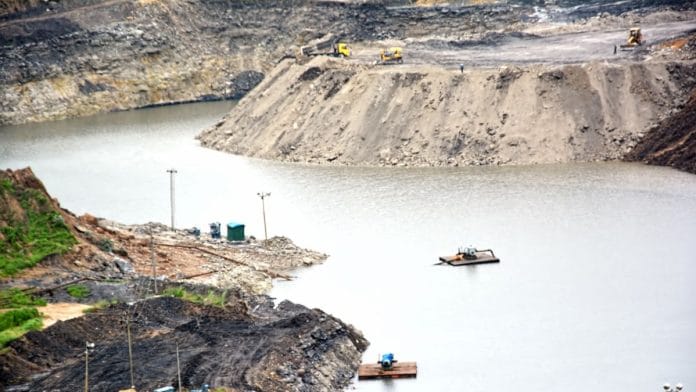Gurugram: Haryana and Punjab are grappling with serious groundwater contamination issues, with growing levels of fluoride, nitrates, and electrical conductivity (EC), according to the latest Annual Ground Water Quality Report-2024 released by the Central Ground Water Board (CGWB).
The report, released this week, indicates an alarming deterioration in groundwater quality across multiple districts, posing serious health hazards and increasing challenges to agriculture.
The report highlights that Haryana and Punjab are among the states with an increasing trend of fluoride concentration exceeding the tolerable limit of 1.5 milligrams per litre.
Among the most affected districts in Haryana are Jind, Sonipat, Bhiwani, Sirsa, and Panipat. In Punjab, Bathinda, Mansa, and Fazilka are severely impacted.
Additionally, Rajasthan, Karnataka, Andhra Pradesh, Telangana, and Gujarat also showed considerable fluoride contamination, making this a nationwide concern.
Also Read: NITI Aayog report says Haryana biggest laggard among its neighbours in higher education
Nitrate pollution attributed to excessive use of fertilisers
Besides fluoride contamination, nitrate pollution, primarily attributed to excessive use of fertilisers in agriculture, has also shown an increasing trend in multiple states, according to the annual groundwater report.
While Haryana and Punjab continue to see rising nitrate concentrations beyond the safe limit of 45 milligrams per litre—owing primarily to the excessive use of fertilisers—over 40 percent of samples from Rajasthan, Maharashtra, Tamil Nadu, and Telangana have also reported higher nitrate contamination levels exceeding the permissible limits.
Elevated nitrate levels in drinking water can cause severe health issues, including methemoglobinaemia or ‘blue baby syndrome’ in infants.
Similarly, Haryana and Punjab have emerged as states with the highest number of districts reporting electrical conductivity levels beyond the permissible limit of 3000 microsiemens per centimetre.
The worst-affected districts in Haryana include Sirsa, Hisar, Bhiwani, Sonipat, Jind, and Gurugram. Punjab’s Fazilka, Bathinda, and Muktsar are also severely affected.
Electrical conductivity is a measure of the ease with which water conducts electricity. It is essentially an indicator of the mineralisation of water and is used to assess the degree of salinity in groundwater. Increasing salinity is linked to the over-extraction of groundwater for irrigation, leading to reduced water quality and soil degradation.
The report noted that the monsoon season brings temporary relief as recharge reduces the concentration of contaminants in some areas. However, in other regions, excessive runoff leads to increased nitrate pollution post-monsoon.
The report suggested a combination of sustainable agricultural practices, improved wastewater management, and enhanced groundwater recharge methods to mitigate these issues.
With groundwater being the primary source of drinking and irrigation water in Haryana and Punjab, experts suggested immediate steps to regulate groundwater extraction, promote rainwater harvesting, and implement stricter pollution control measures.
Groundwater quality crisis requires urgent attention
Mahabir Jaglan, a former professor of geography, told ThePrint that without urgent intervention, the worsening water quality could have severe long-term consequences for both public health and agricultural economy of the region.
“The groundwater quality has emerged as a major environmental health issue in tubewell-irrigated regions of Haryana, and it has consistently deteriorated over the last two decades. The intensification of cropping and expansion of the water-guzzling wheat-rice crop combination in southern and western Haryana have led to excessive mining of groundwater. Add to this the excessive application of nitrogen and phosphate fertilisers to augment soil fertility, along with the indiscriminate use of toxic insecticides and pesticides,” Jaglan said when contacted by ThePrint Wednesday.
He explained that the extraction of groundwater for intensive irrigation has accelerated the processes of the water cycle and altered the geo-chemistry. This has resulted in excessive leaching of toxic compounds from chemical fertilisers and pesticides, leading to excess concentrations of nitrates, fluorides, and soluble salts in many parts of the state.
Jaglan further pointed out that the issue of salinity, measured by electrical conductivity, has particularly emerged in the central and south-western parts of Haryana. The soils in these areas have high natural salinity, and soluble salts in the soil profile easily leach into percolating water, eventually reaching the aquifers.
He added that nitrate concentration in groundwater was particularly high in the wheat-rice regions, where nitrogen fertiliser use was excessive. Meanwhile, arsenic concentration in the state was high only in areas with shallow aquifers in south-western Haryana.
“There is a need to stop excessive groundwater extraction in the state. This is possible only if an effective plan of crop diversification is implemented. The state needs to move away from the wheat-rice crop combination. Farmers must be given remunerative and assured prices for their produce as they transition away from the wheat-rice cropping pattern,” Jaglan emphasised.
Stating that the CGWB report should serve as a wake-up call, Jaglan stressed the need for sustainable water management policies to ensure safe and clean groundwater for Haryana, Punjab, and the rest of the country’s future generations.
(Edited by Radifah Kabir)
Also Read: In letter to PM, ex-IFS officers red-flag Aravalli safari’s focus on govt & private investments







Punjab and Haryana are both cesspools. A burden on the nation.